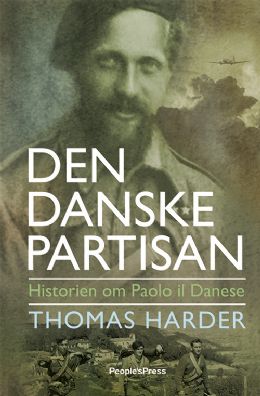Thomas Harder: Den danske partisan – Historien om Paolo il Danese, a biography of Arndt Paul Richardt Lauritzen (1915-1978), 392 pages, Informations Forlag, 2009, 2018; People'sPress, 2018.

Den danske partisan is the true story of the Danish Benedictine monk, priest and Army officer Arndt Lauritzen (1915-1978), who spent most of World War II in Italy where he was involved in the armed Resistance and came to command a Catholic anti-Fascist partisan brigade.
In the early hours of 26 April 1945 Lauritzen and his men were the first partisans to enter the city of Parma, where Lauritzen is still remembered as the liberator of that city. A street in Parma is named after ”Paolo il Danese”.
From the autumn of 1933 until war was declared in September 1939, Arndt Lauritzen was a monk in the great Benedictine abbey of Clervaux in Luxembourg. The abbot of Clervaux, Joseph Odo Alardo, was, among other things, a French spy in close contact with conservative Catholic anti-Nazi circles in Germany and Austria, e.g. Otto von Habsburg. The abbey of Clervaux gave shelter to numerous political refugees, among them the “left wing Nazi” Otto Strasser who was high on Hitler’s death list. As a monk Lauritzen probably did courier-work for Strasser and helped the abbot smuggle refugees across the border between Germany and Luxembourg.
Arndt Lauritzen temporarily left the abbey to do his national service in the Danish Army 1937-38 and was trained as a reserve officer. When Germany invaded Denmark on 9 April 1940, Lauritzen was a junior lieutenant and among the 200 Danish officers and men who under the command of the legendary Colonel Helge Bennike sailed to Sweden aboard a hijacked railway ferry in order to help the Swedes fight off a German invasion which Bennike, and the Swedes, expected to be on its way.
As the invasion didn’t come, Lauritzen and a couple of other young Danish officers tried to get to Norway to join the fight against the German invaders. They didn’t succeed. They then spent some time in Stockholm, where they contacted the British and French military attachés in the hope of being enlisted in one of the Allied armies. This scheme too was unsuccessful, but while Lauritzen and his friends waited for a reply they passed the time investigating a couple of mysterious young German ladies who worked at the German embassy in Stockholm. The two ladies were probably spies and the Swedish authorities were very interested in the evidence gathered by Lauritzen & co., not least because it implicated the Swedish Prince Carl Bernadotte.
In June 1940 Lauritzen returned to Copenhagen where he was involved in some of the earliest activities of the Danish Resistance. He even joined the Danish Nazi party to reconnoitre its premises in preparation for a subsequent bomb attack. Lauritzen was encouraged to undertake this work by the Catholic bishop of Copenhagen, Theodor Suhr.
In November 1940 Lauritzen went to Rome to continue his studies of philosophy and theology, and in December 1942 he took holy orders. In Rome Lauritzen was in touch with Catholic anti-Fascists – among them the colourful French cardinal Eugène Tisserant – and probably worked as an agent for the British intelligence service SIS. In 1943 Lauritzen suddenly disappeared from Rome, only to reappear as the instructor of the son of the Marchese di Soragna-Tarasconi and his Danish wife in their villa outside Parma.
While part of the Soragna-Tarasconi household, Lauritzen read mass and heard confessions at the local parish church. He was also in close contact with local anti-Fascists and probably continued his work for the SIS. In the summer of 1944 the Germans were about to arrest Lauritzen, but he managed to escape and joined a band of partisans in the hills South of Parma. As Lauritzen was one of the very few partisans to speak English, he was appointed liaison officer to the British SOE-mission in the Parma area and he formed a close friendship with its commander, Major A.C. Holland.
Lauritzen’s military skills, extreme motivation, bravery, and charismatic personality made him a natural leader, and during the winter 1944-45 he rose to command the Catholic Partisan brigade 3. Julia, which distinguished itself in the fierce fighting leading up to the German collapse in the spring of 1945.
Immediately after the liberation of Parma Lauritzen’s brigade occupied the local prison where Lauritzen risked his own life preventing an angry mob from lynching the new Fascist inmates.
Arndt Lauritzen left the priesthood immediately after the end of the war and married Rosita who had also been a partisan. The couple had three children. Lauritzen lived most of his remaining years in Italy as a businessman, as a bodyguard for an Italian industrialist, as the manager of a private radio and TV-station – and as a secret agent for Danish and Italian intelligence agencies.
Paolo il Danese tells the story of Arndt Lauritzen’s adventurous life, putting it into the larger historical contexts of pre-war Europe, World War II, the Italian boom-years and the Cold War. The book recounts Lauritzen’s actions as a partisan leader, but also his internal, religious and moral struggle: The difficult concept of ”just war”, the Christian Easter logic, the duty to love one’s neighbour and, not least, the much harder duty to love one’s enemy are some of the problems which Lauritzen had to deal with in very concrete terms when he chose to take up arms against Nazism.
Paolo il Danese is based on meticulous historical research, involving hitherto unpublished archival material from Denmark, Germany, the UK, France, Italy, and Luxembourg, as well as interviews with Lauritzen’s family in Denmark and Italy and with people who knew him as a priest, a soldier and, a partisan.
Arndt Lauritzen and his partisans cooperated closely with the SOE's Toffee Mission which was under the command of Major Algernon Charles Holland. Major James "Jim" Thomas Mann Davies was one of the SOE officers who came to the Parma area with Major Holland.


